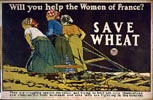4. WWI: Illustration and Explanation, Sobering and Dutiful








 more images below
more images below
by a War-time Billboard
I stand by a fence on a peaceable street
And gaze on the posters in colors of flame,
Historical documents, sheet upon sheet,
Of our share in the war ere the armistice came...
But now as I study that row upon row
Of wind-blown engravings I feel satisfaction
Deep down in my star-spangled heart, for I know
How Art put on khaki and went into action.
There are posters for drives—now triumphantly o'er
I look with a smile reminiscently fond
As mobilized Fishers and Christys implore
In a feminine voice, “Win the War—Buy a Bond!”
There's a Jonas Lie shipbuilder, fit for a frame;
Wallie Morg's “Feed a Fighter” Lurks deep in his trench;
There's Blashfield's Columbia setting her name
In classical draperies, trimmed by the French.
Charles Livingston Bull in marine composition
Exhorts us to Hooverize (portrait of bass).
Jack Sheridan tells us that Food is Ammunition—
We've all tackled war biscuits under that class...
There's the Christy Girl wishing that she was a boy,
There's Leyendecker coaling for Garfield in jeans,
There's the Montie Flagg guy with the air of fierce joy
Inviting the public to Tell the Marines.
And the noble Six Thousand—they count up to that—
Are marshaled before me in battered review.
They have uttered a thought that is All in One Hat
In infinite shadings of red, white, and blue.
And if brave Uncle Sam—Dana Gibson, please bow—
Has called for our labors as never before,
Let him stand in salute in acknowledgement now
Of the fighters that trooped from the studio door.
Unlike the state-produced posters disseminating mostly practical information, nationally distributed posters from World War I were often colorful and highly illustrative. Yet they still used text to explain the conflict abroad and encourage sacrifices at home.
George Creel reprinted the preceding poem in his memoir of WWI to highlight the popularity of posters used in propaganda efforts. 11 The posters often incorporated striking illustrations by well-known professional artists.
Artist Charles Dana Gibson led the Division of Pictorial Publicity, which operated within Creel's Committee of Public Information. The Division recruited commercial and fine artists to fill poster and publicity requests from Washington. Between April 1917 and November 1918, the Division submitted 700 poster designs to 58 government agencies. 12
“Will you help the Women of France? They are struggling against starvation and trying to feed not only themselves and their children, but their husbands and sons who are fighting in the trenches.”
— text from poster produced by the US Food Administration, c.1917National campaigns often made appeals to the moral, religious and patriotic convictions shared by many Americans. Though colorful, the somber illustrations and messages reflected the seriousness of war and famine, and linked homefront behavior to the welfare of soldiers and to the citizens of Europe. These posters urged viewers to understand how individual actions could affect global events.
Posters aimed at younger audiences retained the same overall tone; posters asked children to “enlist” in the School Garden Army, or suggested, “We eat because we work,” while others refer to war explicitly.
Image Gallery |
Next Section







